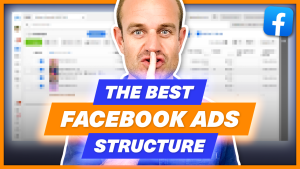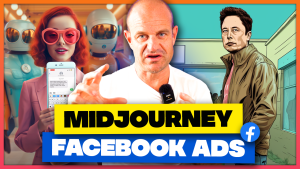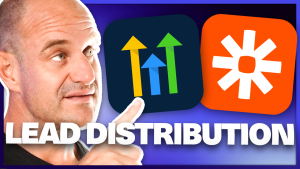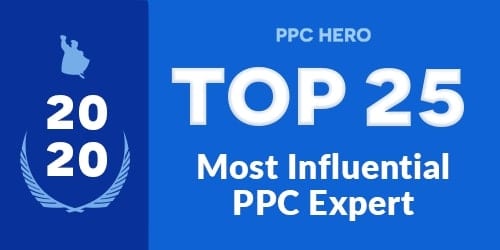So, I’ve already told you that YouTube advertising is the best thing since sliced bread.
If you’re new to this YouTube series of mine, I’ll add some links at the bottom of my post.
For those of you who read and watch my stuff on the regular, today’s blog is about how to cut your cost per lead on YouTube.
First off…
Contents
What Do I Mean By YouTube Ads?
You’ve got three key types of YouTube ad:
- Preroll
- TrueView
- Bumpers
Preroll
Preroll YouTube ads are non-skippable ads that make people watch them until the bitter, bitter end. They can turn up before, after or halfway through the visitor’s chosen video.
As of January 2018, preroll YouTube ads have a time limit of 15-20 seconds.
Preroll ads have their pros and cons, like all forms of advertising. On the one hand, these ads get the best engagement rate of all YouTube ad forms (mainly because the viewer has no choice).
On the other hand, there’s also a higher video abandonment rate.
If you choose to use preroll ads, make sure your story is TIGHT. 20 seconds is long enough to have characters, dialogue, and build brand awareness. Make sure you include a call to action and give your viewers something to click.
Bear in mind that YouTube’s preroll videos are charged on a PPC (pay per click) basis. A crappy landing page beyond the YouTube ad could waste a hell of a lot of money.
Bumpers
Bumper YouTube ads are the shortest of all the ad styles. At a mere 6 seconds long, they’re non-skippable and play before the viewer’s chosen video.
If you want to use bumper videos, I highly recommend you use them as part of a larger video campaign. With the correct targeting, your audience will hopefully see a mixture of your TrueView, preroll and bumper ads.
Bumper ads are all about brand-awareness. Get your logo up there, and make sure you’ve got one hell of a tagline.
TrueView
TrueView ads are the standard on YouTube, and the type we use at Flexxable and Flexx Digital.
YouTube doesn’t have a strict time-restriction for TrueView ads, so they can last between 12 seconds and 6 minutes in length.
That said, viewers have the option to skip a TrueView ad after 5 seconds. So, if you want to get their attention, do it quickly.
However, the great thing about TrueView is that you only pay when viewers watch or interact with the ad. For example, if a viewer chooses not to skip after 5 seconds, but skips after 10, you won’t pay anything.
YouTube only counts the ad as “watched” after a full 30 seconds or until the advertisement reaches the end. You’ll also pay if the viewer interacts with your ad, such as clicking on a link. Again, make sure that click is worth it for the user.
Did you know there are actually two types of YouTube TrueView ad? You’ve got Video Discovery and In-Stream ads.
Video Discovery and In-Stream
Video Discovery YouTube ads show up on the YouTube homepage, in YouTube search and in the “related videos” bar.
TrueView In-Stream ads play before the visitor’s selected YouTube video. You can choose to have TrueView In-Stream ads play anywhere in the Google Display Network (GDN), or sites that have bought Google video ad space.
In-Stream ads will let advertisers overlay all sorts of cool graphics and CTAs over the videos.
In-Stream ads shouldn’t be considered equal to television commercials.
Remember that Cadbury’s advert with the two children squeaking a balloon? If not, here it is, below:
Described as anything between “brilliant” to “creepy”, this ad certainly caught people’s attention (and imagination if the comments are anything to go by).
However, there’s one thing that glaringly stands out: in the one-minute advert, Cadbury’s directly advertises their chocolate for the grand total of three seconds.
You can’t afford to do this. Unless you’re on the same level as Cadbury’s, treat your YouTube In-Stream ad as a video sales letter.
The best examples of YouTube TrueView ads I have ever seen are by the Harmon Brothers.
Founded in 2013, the Harmon Brothers ad company have made advertisements for Squatty Potty, ClickFunnels, Lume, Purple and FiberFix.
Their ads are the perfect mixture of regular TV commercials and infomercials. Running at about 4 minutes long, pretty much every ad has reached “viral” status. Collectively, they’ve helped drive $300 million in sales.
Here’s an example of a Harmon Brother’s In-Stream ad:
Notice that the script is both informative and entertaining.
Obviously, this ad required an enormous budget. However, in their Harmon Brothers University course, the brothers admitted you don’t need a huge budget to create a YouTube ad that sells.
One of their students had a video budget of $400 and managed to earn $42,000. That’s 105x what he paid.
Now that I’ve explained the difference between the three types of YouTube ad, let’s move onto how to cut your cost per lead on YouTube ads.
1. Cut Your YouTube Cost Per Lead Via Bidding
YouTube is owned by Google, so all bidding is done via AdWords.
Thankfully, due to Facebook’s user-friendly interface, Google AdWords has done its best to become more accessible for its users.
Google AdWords has got loads of different bid options, like CPC (cost per click), CPV (cost per view) and CPA (cost per action).
At Flexx Digital, we concentrate mainly on Target CPA. That means we’ll tell Google what we want to pay per lead, and Google will do its best to find leads for that price.
Thanks to advances in AI and the algorithm, setting a bidding budget is no longer the hassle that it used to be. Constant machine learning means you can go straight into Target CPA bidding, and the algorithm sorts itself out almost overnight.
However, if you’re still not getting the cost per lead you want with your YouTube ads, consider experimenting with different bid levels.
You’ll find that your cost per lead will fluctuate based on ad length, creative quality, targeting and auction dynamics.
Also note that, although YouTube ads have a much longer shelf life than Facebook’s, a rising CPL could be a sign of creative fatigue.
2. Cut Your YouTube Cost Per Lead With Audience Targeting Methods
You can cut your cost per lead on YouTube by correctly defining your audience targeting.
AdWords has a tonne of audience targeting methods to use on YouTube. You’ve got:
- Demographic groups: You can choose the age, gender and household income of your audience.
- Detailed demographics: These are additional traits you can choose from, including whether or not your audience consists of students, homeowners, or new parents.
- Interests: This gives you the power to advertise to people who’re interested in specific issues, even when they’re visiting pages about other topics.
- Affinity audiences: YouTube gives you the option to target people who already have a keen interest in your ad’s key topic.
- Custom affinity audiences: Ever made a custom audience on Facebook? This targeting method allows you to get much more granular with your targeting. For example, if you’re advertising car finance, you could reach business owners looking to lease a company car.
- Life events: Want to target audiences that have just got married? Or people who’re heading towards retirement? Life events targeting will let you do that.
- In-market audiences: Want to target people who are actively searching for products or services that are just like yours? You may want to look at your in-market audiences.
- Custom intent audiences: This is where viewers begin to question “can advertisers read my mind?”. Custom intent audiences allow you to advertise to people who’ve recently searched for similar keywords on Google.com.
- Topics: This method will allow you to target audiences interested in specific topics. For example, if you target “Writing and Editing Services”, your ad will show on YouTube to people looking up videos about copywriting.
- Devices: You can target users based on their use of device, such as smartphones, laptops, and Chromecast.
How granular you want to get with your targeting depends on how much you’re willing to pay for that click. If you’re advertising to a vast audience, you may see your YouTube cost per lead spike before the Google algorithm sorts itself.
If you’re targeting a hyper-granulated audience, be aware that your cost per lead may spike over time, as Google searches for audiences that suit your targeting.
My advice: adjust your audience targeting and your bid tactics until you find a way to cut your cost per lead to a level you’re happy with.
3. Lower Your YouTube Cost Per Lead With Good Creative
You can spend hours and hours in AdWords fiddling around with bids and audiences.
However, I find that the real key to a successful YouTube campaign (with a low cost per lead!) is your ad creative.
Many people don’t even attempt YouTube advertising, as they find the prospect of writing a script, hiring actors and shooting in a studio daunting.
However, your script doesn’t have to be high-art. Not every ad is destined to become a viral sensation, but they can all be entertaining and functional.
Here’s a quick run-down on how to piece together your YouTube script. Having a great script is the no.1 way to cut your cost per lead on YouTube.
Section 1 – Your Hook.
You need to call out your audience from the very beginning. This could be something as simple as asking a rhetorical question: “Are you a [man/woman/dad/mum] who’s tired of [being in debt/expensive car insurance/waiting decades to pay off your mortgage]?”
Using “tired of” or “fed up of” feeds directly into the emotional mindset of your audience. If they’re not “fed up” then that ad’s not for them. No biggie!
Section 2 – Build Emotion.
Talk about the audience’s critical problem – and make sure it’s only one. If you try and take on too much in one vid, you risk confusing your audience.
Shoot straight to the heart of the matter: “The biggest problem a lot of [men/women/mums/dads/etc.] face is [insert their critical issue]. Expanding on their problem also provides context for the viewer.
Section 3 – Why Am I A Credible Speaker?
What gives you the right to speak on the topic?
Have you been through the same problem yourself? Are you an “expert” in the field?
If you choose the “expert” route, please make sure you either are or hire an actual expert. Audiences don’t appreciate being lied to, and a quick Google search will uncover your credibility (or not).
You can also drop your brand name at this point. I.e. “[YOUR BRAND] has helped thousands of [women/men/dads/mums] out of [KEY PROBLEM].
Section 4 – Solution.
How can [YOUR BRAND] help that person right now?
It’s important not to expect too much from your audience at this point. If your product/service costs a lot of money, a two-minute ad isn’t going to persuade them to take the plunge.
Start off small with a quiz, asking for their details, and promise them a free gift in return: “We created this [FREE TOOL] that will show you how to [INSERT DESIRE]”.
Section 5 – Call To Action.
It’s the end of your story, but it’s not the end of theirs. Ask your audience to “complete their story” by encouraging them to click the link/give their details/arrange a phone call. Make it sound like the solution to their biggest problem is within arm’s reach. Remind them that, if they’re still watching your video, they need your solution. Your viewer needs to feel a strong sense of investment.
Did you know that our Flexxable Pay Per Lead course offers you a full template video script for your YouTube ads?
We’re not just pretty faces, we also give you super useful stuff. All the time. Just sayin’.
3.5. The Creative Isn’t JUST Your YouTube Ad Script
Yep, you heard right.
For every video, we hire at least two to three actors that will appeal to our audiences.
We ask every actor to read from the same script, then we edit it into our YouTube ad. It all comes down to split-testing.
The results may surprise you. For one of our YouTube ads, we were sure that a white woman in her mid-forties would be the most popular with our audience. However, the ad that worked best was a black woman in her late-thirties.
In another video, we had four actors. Three were very good, but one struggled. We thought the last one had no chance, but her video blew the rest out of the water. Just proves: you never can tell.
Our Flexxable Pay Per Lead training teaches you how to find and hire actors for your YouTube ad. It also provides templates for casting calls, release forms, and call sheets.
You’ll also get the full run-down on how to hire a studio, how much to pay your actors, and whether or not it’s worth hiring a production company for your particular product.
You want it, we give it. It’s what we do.
4. Cut Your YouTube Cost Per Lead With A Great Hook
Hooks and the creative go hand in hand.
However, without a solid hook as your foundation, your creative won’t be going anywhere.
Hooks should:
- Announce more information
- Be surprising. Catching a prospect off-guard gets their attention
- Be exclamatory or emotional
- Promise a benefit or a solution
Get the hook right, and the probability of converting a “browsing prospect” into a “paying customer” increases significantly.
It won’t surprise you that hooks are difficult to come up with. You may find yourself writing 20, 30 or even 40 before you’re happy with one.
When I’m trying to come up with a sales hook, I keep these three things in mind:
Inevitability
Intrigue
Promise/Solution
For example, Last year, PPC Manager, Graham Connolly, wrote the following hook for a debt service: “How mums are writing 75% off their debt”.
After clearly defining his audience (mums), he tapped into the same three selling points:
- Inevitability: People get into debt and have to pay it back
- Intrigue: How did these mums get so much debt written off?
- Promise/Solution: Watch the video, and you can do the same.
Notice that Graham specifically called out mums?
One problem that affects a lot of marketers is that they try to make their offer appeal to everybody.
Guess what? That’s the fastest way to appeal to nobody.
Take the broad niche that is car finance, for example. Most car finance companies offer the same hook every single time.
For example:
“Car finance. Cheapest rates, no deposit.”
Yaaaaaaawn. Everybody and his wife are offering the exact same thing.
With broad niches like this, I try to dig a bit deeper. When the market is saturated with the same service, see if you can make your offer appeal to one segment of the market.
My copywriter wrote a dummy advertorial recently, about the same niche. Her chosen hook was: “Car Finance for business owners. Is buying a car through your business financially wise? It depends on your situation. Take this survey to find out.”
She then titled the advertorial: 3 Things You Need To Know Before Buying A Company Car.
Though I’m talking about advertorials here, the same applies to your YouTube video hook.
There are thousands upon thousands of business owners, so being specific with your targeting isn’t going to close off sales opportunities. You’ll also find your offer is much more appealing if the target thinks you’re solving a problem that concerns them directly.
And, if you concentrate on one portion of the market, you’ll eventually find yourself a specialist in that area. Becoming a master of your target market is an excellent way to cut your cost per lead on YouTube. You’ll have better ads, better successes, better averages… the possibilities are endless.
5. Lower Your YouTube Cost Per Lead With A Great Sales Funnel
Just as with Facebook, your overall YouTube cost per lead often depends on what’s going on beyond the platform.
If your landing page isn’t up to scratch, your visitor will view your offer as a wasted click.
The key to building the perfect landing page is split-testing. Flexx Digital drives millions of clicks per year, and we regularly split test our pages.
If you’re not split-testing, you’re definitely leaving money on the table.
See, the only way you’ll find out how well your lead campaigns are working is via audience engagement.
Spent ages on a landing page and love the way it looks? The harsh reality is that if your target audience hates it, you’re not going to generate any leads.
It doesn’t mean that your writing is terrible, or the image quality is poor. It just means that the landing page doesn’t appeal to the specific group of people you’re trying to target.
So, a split-test is a way of testing multiple versions of your landing page against one another to see which version works best.
Sometimes, your variations can test significant elements, such as layout, writing style and page design.
Other times, it may be as simple as changing one word in a headline or a specific image.
It really doesn’t take much for an audience to turn against you!
You need to approach split-testing the same way you would a science experiment. All split tests start with a control – aka the original version of whatever part of the sales funnel you’re testing.
To make it a split test, you’ll also need a variant. You can have one of these, or two, or three. As long as an equal portion of your traffic is sent to the control and its variants, you’ll have a clear indication of which comes out top.
When it comes to creating your variants, don’t change something just for the sake of change. Your market research should tell you what kind of writing style, images, copy and design your target audience will respond to. A split test will help you get all the details right, maximising the lead conversions for your campaign.
At the end of your split testing, you should:
- Have got rid of any guesswork in your marketing campaign
- Be able to create better content
- Know how customers truly respond to the presentation of your offer
- Have maximised your web traffic
- Yield a higher ROI than before
If you fail to split test your landing pages, thank you pages, etc., and experience a high drop-off rate, YouTube will pick up on this and penalise you. This can cause your cost per lead to spike.
Changing your ad creative will only get you so far. If you’ve got a brilliant YouTube ad, but your landing page still sucks, you’ll find yourself repeating the same pattern again and again.
Conclusion
To cut your YouTube cost per lead, you must be aware of everything going on in AdWords, behind the creative and beyond the customer’s first click.
I think the key takeaway we have here is that, to cut your cost per lead, you need to know your audience. The best way to do that? A customer avatar and empathy map. Click here to see the post.
Links To Other YouTube Posts:
The Don’ts Of YouTube Advertising
5 Top Tips For Quick And Profitable YouTube Ads
Free Training
Flexx Digital is a PPC agency that uses the Pay Per Lead model – no retainer contracts.
If you want to find out more about this Pay Per Lead model, and how we run the business, check out my free case study.
Inside you’ll find how I:
- Severed ties with retainer contracts once and for all
- Moved away from local businesses
- Started working with national B2C companies
- Land high-ticket clients
- Found the verticals we work in
- Consistently generate leads of the highest quality
Click below to watch it now:









